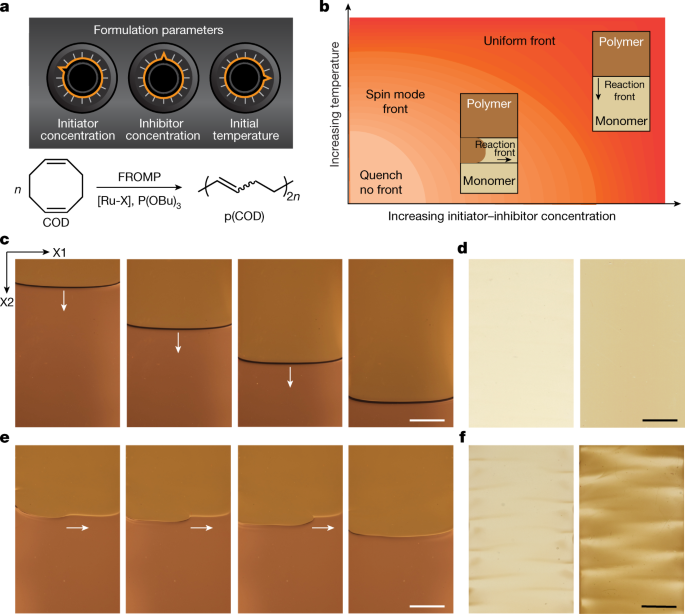Autonomous Fabrication of Patterned Crystalline Domains in Polymers through Frontal Polymerization
Основные понятия
Frontal polymerization can be harnessed to autonomously fabricate patterned crystalline domains in polymers, enabling the control of material properties through the manipulation of processing conditions.
Аннотация
The content describes a novel approach to fabricating hierarchical architectures in synthetic materials that combine soft and hard domains. The key insights are:
- Frontal polymerization spin mode dynamics can be used to autonomously create patterned crystalline domains in poly(cyclooctadiene) polymers.
- This rapid, dissipative processing method leads to the formation of amorphous and semi-crystalline domains at the internal interfaces between the solid polymer and the propagating cure front.
- The size, spacing, and arrangement of the domains can be controlled by adjusting the interplay between the reaction kinetics, thermochemistry, and boundary conditions.
- Small changes in the fabrication conditions can reproducibly lead to remarkable changes in the patterned microstructure, resulting in significant differences in the mechanical properties (strength, elastic modulus, and toughness) of the final polymer.
- This ability to control material properties solely through the initial conditions and the mode of front propagation represents a significant advancement in the design and manufacturing of advanced multiscale materials.
Настроить сводку
Переписать с помощью ИИ
Создать цитаты
Перевести источник
На другой язык
Создать интеллект-карту
из исходного контента
Перейти к источнику
www.nature.com
Controlled patterning of crystalline domains by frontal polymerization - Nature
Статистика
Hierarchical architectures in synthetic materials can combine soft and hard material domains with coalesced interfaces, leading to superior properties compared to homogeneous counterparts.
Deterministic manufacturing strategies like 3D printing require a priori design and active intervention to achieve architectures spanning multiple length scales.
Цитаты
"This rapid, dissipative processing method leads to the formation of amorphous and semi-crystalline domains emerging from the internal interfaces generated between the solid polymer and the propagating cure front."
"Small perturbations in the fabrication conditions reproducibly lead to remarkable changes in the patterned microstructure and the resulting strength, elastic modulus and toughness of the polymer."
Ключевые выводы из
by Justine E. P... в www.nature.com 09-18-2024
https://www.nature.com/articles/s41586-024-07951-7
Дополнительные вопросы
How can the insights from this work be applied to the development of other types of hierarchical materials beyond polymers?
The insights gained from the controlled patterning of crystalline domains through frontal polymerization can be extended to the development of various hierarchical materials beyond polymers, such as ceramics, composites, and biomaterials. The fundamental principles of manipulating reaction kinetics, thermochemistry, and boundary conditions can be adapted to other material systems. For instance, in ceramics, similar techniques could be employed to create patterned microstructures that enhance mechanical properties like toughness and strength. By controlling the sintering process and the temperature gradients, one could achieve a hierarchical architecture that optimizes performance. In composite materials, the integration of different phases (e.g., fibers or nanoparticles) can be guided by the same principles, allowing for the design of materials with tailored properties for specific applications, such as lightweight structural components or advanced thermal insulators. Furthermore, in biomaterials, the ability to create multiscale architectures could lead to improved scaffolds for tissue engineering, where the mechanical and biological properties are finely tuned to promote cell growth and differentiation.
What are the potential limitations or challenges in scaling up this frontal polymerization approach for industrial-scale manufacturing of patterned crystalline materials?
Scaling up the frontal polymerization approach for industrial applications presents several challenges. One significant limitation is the control of uniformity and consistency across larger volumes. As the size of the system increases, maintaining the same reaction kinetics and thermodynamic conditions becomes more complex, potentially leading to variations in the microstructure and properties of the final material. Additionally, the heat generated during the polymerization process can create thermal gradients that may affect the propagation of the cure front, resulting in non-uniform patterns. Another challenge is the integration of this technique into existing manufacturing processes, which may require significant modifications to equipment and protocols. Moreover, the reproducibility of the desired microstructures under varying environmental conditions (e.g., humidity, temperature) must be ensured to meet industrial standards. Finally, the economic feasibility of large-scale production, including the cost of raw materials and energy consumption, must be evaluated to determine the viability of this approach in a commercial setting.
What other physical or chemical phenomena, beyond reaction kinetics and thermochemistry, could be leveraged to further expand the control and tunability of the patterned microstructures and resulting material properties?
Beyond reaction kinetics and thermochemistry, several other physical and chemical phenomena can be leveraged to enhance the control and tunability of patterned microstructures. One such phenomenon is phase separation, which can be utilized to create distinct domains within a material by manipulating the composition and processing conditions. This can lead to the formation of complex microstructures with tailored mechanical properties. Additionally, the use of external fields, such as electric or magnetic fields, can influence the alignment and orientation of molecular chains or particles during the polymerization process, resulting in anisotropic properties. Self-assembly techniques, driven by molecular interactions, can also be employed to create hierarchical structures at the nanoscale, which can be integrated into the larger microstructure. Furthermore, incorporating stimuli-responsive materials that change properties in response to environmental triggers (e.g., temperature, pH, or light) can provide dynamic control over the material's performance. By combining these phenomena with frontal polymerization, researchers can develop advanced materials with unprecedented levels of customization and functionality.
0
